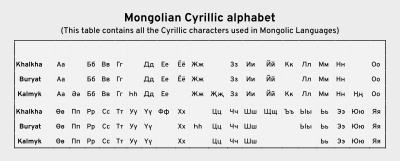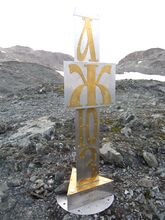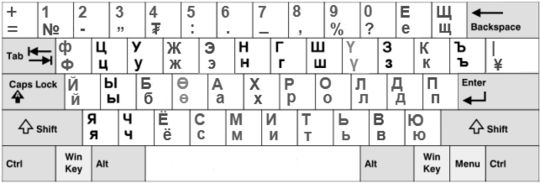الأبجدية السيريلية المنغولية
| السيريلية المنغولية | |
|---|---|
 | |
| النوع | |
| اللغات | المنغولية |
| الفترة الزمنية | ع1940 – الحاضر |
النظم الوالدة | |
| الاتجاه | Left-to-right |
| ISO 15924 | Cyrl, 220 |
مرادف اليونيكود | Cyrillic |
| فئة جزئية من Cyrillic (U+0400...U+04FF) | |
الأبجدية السيريلية المنغولية (بالمنغولية: Монгол Кирилл үсэг, Mongol Kirill üseg or Кирилл цагаан толгой, Kirill tsagaan tolgoi) is the writing system used for the standard dialect of the Mongolian language in the modern state of Mongolia. It has a largely phonemic orthography, meaning that there is a fair degree of consistency in the representation of individual sounds. Cyrillic has not been adopted as the writing system in the Inner Mongolia region of China, which continues to use the traditional Mongolian script.
. . . . . . . . . . . . . . . . . . . . . . . . . . . . . . . . . . . . . . . . . . . . . . . . . . . . . . . . . . . . . . . . . . . . . . . . . . . . . . . . . . . . . . . . . . . . . . . . . . . . . . . . . . . . . . . . . . . . . . . . . . . . . . . . . . . . . . . . . . . . . . . . . . . . . . . . . . . . . . . . . . . . . . . .
التاريخ
Mongolian Cyrillic is the most recent of the many writing systems that have been used for Mongolian. It uses the same characters as the Russian alphabet except for the two additional characters Өө ⟨ö⟩ and Үү ⟨ü⟩.
It was introduced في ع1940 في جمهورية منغوليا الشعبية under Soviet influence,[2] after two months in 1941 where Latin was used as the official script, while Latinisation in the Soviet Union was in vogue. After the Mongolian democratic revolution in 1990, the traditional Mongolian script was briefly considered to replace Cyrillic, but the plan was canceled in the end. However, the Mongolian script has become a compulsory subject in primary and secondary schooling and is slowly gaining in popularity.[3] The Mongolian script is a highly uncommon vertical script, and unlike other historically vertical-only scripts such as the Chinese script it cannot easily be adapted for horizontal use, which puts it at a disadvantage compared to Cyrillic for many modern purposes. Thus, the Cyrillic script continues to be used in everyday life.[بحاجة لمصدر]
In March 2020, the Mongolian government announced plans to use both Cyrillic and the traditional Mongolian script in official documents by 2025.[4][5][6]
In China, Cyrillic alphabet also used by the Chinese to learn the modern Mongolian language, and by some Mongols in Inner Mongolia to demonstrate their ethnic identity.[7][8]
الوصف
The Cyrillic alphabet used for Mongolian is as follows (with borrowed sounds in parentheses):
| Pos. | Cyrillic | Braille | Name | IPA[9] | ISO 9 | Standard romanization (MNS 5217:2012)[10][11] |
Library of Congress |
Mongolian script counterpart |
|---|---|---|---|---|---|---|---|---|
| 1 | Аа | ق.م. | а | a | а | ᠠ | ||
| 2 | Бб | ق.م. | бэ | p, pʲ | b | ᠪ | ||
| 3 | Вв | ق.م. | вэ | w̜, w̜ʲ | v | ᠸ | ||
| 4 | Гг | ق.م. | гэ | ɡ, ɡʲ, ɢ | g | ᠭ | ||
| 5 | Дд | ق.م. | дэ | t, tʲ | d | ᠳ | ||
| 6 | Ее | ق.م. | е | ji~jɵ | e | ye | e | ᠶᠡ |
| 7 | Ёё | ق.م. | ё | jɔ | ë | yo | ë | ᠶᠣ |
| 8 | Жж | ق.م. | жэ | tʃ | ž | j | zh | ᠵ |
| 9 | Зз | ق.م. | зэ | ts | z | ᠽ | ||
| 10 | Ии | ق.م. | и | i | i | ᠢ | ||
| 11 | Йй | ق.م. | хагас и | i | j | i | ĭ | ᠢ |
| 12 | Кк | ق.م. | ка | kʰ, kʲʰ, x, xʲ | k | ᠺ | ||
| 13 | Лл | ق.م. | эл | ɮ, ɮʲ | l | ᠯᠠ | ||
| 14 | Мм | ق.م. | эм | m, mʲ | m | ᠮ | ||
| 15 | Нн | ق.م. | эн | n, nʲ, ŋ | n | ᠨ | ||
| 16 | Оо | ق.م. | о | ɔ | o | ᠣ | ||
| 17 | Өө | ق.م. | ө | ɵ~o | ô | ö | ᠥ | |
| 18 | Пп | ق.م. | пэ | pʰ, pʰʲ | p | ᠫ | ||
| 19 | Рр | ق.م. | эр | r, rʲ | r | ᠷ | ||
| 20 | Сс | ق.م. | эс | s | s | ᠰ | ||
| 21 | Тт | ق.م. | тэ | tʰ, tʰʲ | t | ᠲ | ||
| 22 | Уу | ق.م. | у | ʊ | u | ᠤ | ||
| 23 | Үү | ق.م. | ү | u | ü | ᠦ | ||
| 24 | Фф | ق.م. | фэ, фа, эф | f, pʰ | f | ᠹ | ||
| 25 | Хх | ق.م. | хэ, ха | x, xʲ | h | kh | ᠬ | |
| 26 | Цц | ق.م. | цэ | tsʰ | c | ts | ᠴ | |
| 27 | Чч | ق.م. | чэ | tʃʰ | č | ch | ᠴᠤ | |
| 28 | Шш | ق.م. | ша, эш | ʃ | š | sh | ᠱ | |
| 29 | Щщ | ق.م. | ща, эщэ | (ʃ) | ŝ | sh | shch | ᠰᠢ |
| 30 | Ъъ | ق.م. | хатуугийн тэмдэг | none | ʺ | i | ı | ᠢ |
| 31 | Ыы | ق.م. | эр үгийн ы | i | y | |||
| 32 | Ьь | ق.م. | зөөлний тэмдэг | ʲ | ʹ | i | ||
| 33 | Ээ | ق.م. | э | e~i | è | e | ê | ᠡ |
| 34 | Юю | ق.م. | ю | jʊ, ju | û | yu | iu | ᠶᠦ |
| 35 | Яя | ق.م. | я | ja | â | ya | ia | ᠶᠠ |

Үү and Өө are sometimes also written as the Ukrainian letters Її (or Vv) and Єє respectively,[12] when using Russian software or keyboards that do not support them.
Initial long vowels and non-initial full vowels are written with double vowel letters, while initial short vowels and non-initial epenthetic vowels are written with single vowel letters. Conversely, every vowel letter except у and ү can also represent schwa and zero in non-first syllables. Palatalisation is indicated by и (i), the soft sign ь (') or е (ye), ё (yo), я (ya) and ю (yu) after the palatalised consonant. These latter letters are pronounced without [j] in that position. Щ is never used in Mongolian and only used in Russian words containing the letter.[13] It is pronounced identically to Ш, and is often omitted when teaching the Cyrillic alphabet. Sometimes, Russian loanwords with Щ will be spelled with Ш instead: борш, Хрушев. The difference between [e~i] might be dialectal,[14] while the difference between ɵ~o is positional.[15]
/ɡ/ and /ɢ/ are both indicated by the letter г ⟨g⟩, but the phonetic value of that letter is mostly predictable. In words with "front" (+ATR) vowels (see Mongolian phonology for details), it always means /ɡ/, because only /ɡ/ occurs in such words. In words with "back" (−ATR) vowels, it always means /ɢ/, except syllable-finally, where it means /ɡ/; to acquire the value of /ɢ/, it is written as followed by a single mute syllable-final vowel letter. Similarly, a mute vowel is added to final н ⟨n⟩ to make it denote /n/ and not /ŋ/. ф (f) and к (k) are loan consonants and will often be adapted into the Mongolian sound system as [pʰ] and [x].[13]
The original plan as at 10 October 1945 was to use э only at the beginning of words and in long vowel combinations (as is done in other languages written using Russian-based Cyrillic), дз for modern з, дж for modern ж, ии for modern ий and йө for modern е (to represent the "yö" sound at the beginning of words), but the alphabet was changed to its final form on 13 November.[16]
. . . . . . . . . . . . . . . . . . . . . . . . . . . . . . . . . . . . . . . . . . . . . . . . . . . . . . . . . . . . . . . . . . . . . . . . . . . . . . . . . . . . . . . . . . . . . . . . . . . . . . . . . . . . . . . . . . . . . . . . . . . . . . . . . . . . . . . . . . . . . . . . . . . . . . . . . . . . . . . . . . . . . . . .
Keyboard layout
The standard Mongolian Cyrillic keyboard layout for personal computers is as follows:
انظر أيضاً
المراجع
- ^ Himelfarb, Elizabeth J. "First Alphabet Found in Egypt", Archaeology 53, Issue 1 (Jan./Feb. 2000): 21.
- ^ Will Mongolia Have the Courage to Scrap the Russian Alphabet?
- ^ "Монгол бичиг XXI зуунд хэлэлцүүлгээс уриалга гаргалаа" [Announcements from the "Mongolian script in the 21st century" debate]. 13 May 2011 (in المنغولية). GoGo.mn. Retrieved 20 February 2012.
- ^ "Mongolia to promote usage of traditional script". China.org.cn (March 19, 2020).
- ^ Official documents to be recorded in both scripts from 2025, Montsame, 18 March 2020.
- ^ Mongolian Language Law is effective from July 1st, Gogo, 1 July 2015. "Misinterpretation 1: Use of cyrillic is to be terminated and only Mongolian script to be used. There is no provision in the law that states the termination of use of cyrillic. It clearly states that Mongolian script is to be added to the current use of cyrillic. Mongolian script will be introduced in stages and state and local government is to conduct their correspondence in both cyrillic and Mongolian script. This provision is to be effective starting January 1st of 2025. ID, birth certificate, marriage certificate and education certificates are to be both in Mongolian cyrillic and Mongolian script and currently Mongolian script is being used in official letters of President, Prime Minister and Speaker of Parliament."
- ^ 侯万庄, 王浩 (2017-01-01). 现代蒙古语教程 Орчин цагийн монгол хэлний сурах бичиг. Beijing: 北京大学出版社. ISBN 9787301272312.
- ^ "Өвөр монголчуудын өв соёл, үнэт зүйлс аажмаар замхрах аюул нүүрлээд байна". iSee.mn (in المنغولية). Гадаад мэдээ.
- ^ Svantesson, Jan-Olof, Anna Tsendina, Anastasia Karlsson, Vivan Franzén. 2005. The Phonology of Mongolian. New York: Oxford University Press: 30-40.
- ^ "Монгол кирил үсгийн латин хөрвүүлгийн шинэ стандарт батлагдлаа" [New latinization standard for Mongolian cyrillic script approved]. 18 February 2012 (in المنغولية). GoGo.mn. Retrieved 20 February 2012.
- ^ kirill-useg-standart.jpg, basic table on archive.today
- ^ Sühbaatar, B. "Mongol helnij kirill üsgijg latin üsgeer galiglah tuhaj". InfoCon. Archived from the original on 2009-01-29. Retrieved 2009-01-03.
- ^ أ ب Svantesson et al. 2005: 30-40.
- ^ Svantesson et al. 2005 who proclaim a merger. Luvsanjav, J. (1975): Mongol avianii duudlaga. Ulaanbaatar: MUIS: 14-15 claims that word-initial e-s are articulated towards i, while others are not. But LaCross, Amy (2012): Non-adjacent Phonological Dependency Effects on Khalkha Mongolian Speech Perception. Proceedings of the 29th West Coast Conference on Formal Linguistics, ed. Jaehoon Choi et al., 143-151. Somerville, MA: Cascadilla Proceedings Project, 143-151 keeps them distinct
- ^ Svantesson et al. 2005: 1-10.
- ^ Tseveliin Shagdagsüren, Mongolchuudyn üseg bichigiin tovchoon, 2001, page 190
- تحويل قالب:لغات منغوليا
- تحويل قالب:موضوعات منغوليا
- CS1 المنغولية-language sources (mn)
- Short description is different from Wikidata
- Articles with hatnote templates targeting a nonexistent page
- Scripts with ISO 15924 four-letter codes
- Articles containing منغولية-language text
- Articles with unsourced statements from November 2022
- Pages with empty portal template
- Cyrillic alphabets
- Mongolian writing systems
- Mongolia–Soviet Union relations
- Mongolia–Russia relations

